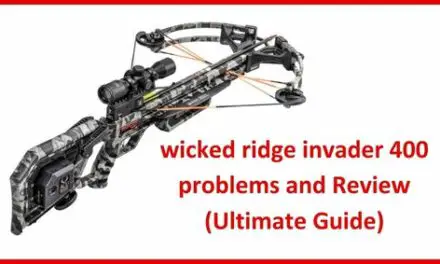The TenPoint Turbo S1 is a crossbow model manufactured by TenPoint Crossbows. It is known for its compact size and high performance, offering speeds of up to 390 feet per second (fps) and generating 135 ft-lbs of kinetic energy. The Turbo S1 features the RX-6 Cam system, which contributes to its long-range accuracy and power.
TenPoint Turbo S1
The TenPoint Turbo S1 Crossbow boasts several impressive features and specifications.
With its short and compact design, measuring only 31 inches in length, it is one of the shortest forward-draw crossbows offered by TenPoint.
Equipped with the RX-6 Cam system, it delivers high speeds and long-range accuracy. The Turbo S1 can shoot arrows at speeds of up to 390 fps, providing a remarkable 135 ft-lbs of kinetic energy.
Its silent and easy cocking mechanism, along with safe de-cocking capabilities, ensures convenience and safety. The crossbow’s quad limb design contributes to its power and performance.
Additionally, the Turbo S1 incorporates the ACUslide system, allowing for effortless and controlled cocking and de-cocking of the crossbow.
TenPoint Turbo S1 Specs
The TenPoint Turbo S1 crossbow has the following specifications:
- Speed : The Turbo S1 shoots arrows at speeds of up to 390 feet per second (fps).
- Draw Weight : The crossbow has a draw weight of 220 pounds.
- Power Stroke: The power stroke of the Turbo S1 is 11 inches.
- Weight: The crossbow itself weighs approximately 7.3 pounds.
- Length: The Turbo S1 measures 31 inches in length.
- Cocking and De-cocking: The crossbow features easy and safe cocking and de-cocking mechanisms, including the ACUslide system.
- Color Options : The Turbo S1 is available in Moss Green.
- Scope: The crossbow comes equipped with the RangeMaster Pro Variable Speed Scope.
- Quiver : The Turbo S1 includes a 3-arrow quiver.
- Kinetic Energy: The Turbo S1 generates around 135 ft-lbs of kinetic energy with a 400-grain bolt.
TenPoint Turbo S1 Features:
- ACUslide™ System: The Turbo S1 features the innovative ACUslide™ cocking and de-cocking system, ensuring both ease and safety during use.
- Impressive Speed and Compact Design: With speeds of 390 FPS (400-grain arrow) and a compact 31-inch length, it combines power with maneuverability.
- Exclusive Finishes: Choose from the exclusive Vektra™ camo pattern or Moss Green, arriving fully assembled in a Ready-To-Hunt package.
- Auto-Brake Gear System: Enhanced safety is provided by the Auto-Brake Gear System for silent and controlled cocking and de-cocking.
- RX6-Cams™: The forward draw bow assembly with RX6-Cams™ delivers exceptional speed and accuracy.
- S1™ Trigger: The two-stage, zero-creep S1™ trigger ensures a consistent 3.5-pound pull and reduced noise.
- MICRO-TRAC™ Barrel: The ultra-short MICRO-TRAC™ fluted aluminum barrel increases accuracy and string life.
- TEC-TAC™ Stock: Comfortable and designed for alignment, complemented by the RangeMaster® PRO Scope.

TenPoint Turbo S1 Problems
ACUslide system Issues
The ACUslide system in the TenPoint Turbo S1 crossbow is designed to provide a smooth and controlled method of cocking and de-cocking the crossbow.
While this system is generally reliable, there can be potential problems that users may encounter. Let’s explore some of these potential problems and their possible solutions.
Misalignment:
One possible issue with the ACUslide system is misalignment, where the components may not be properly aligned. This can cause difficulty in engaging or disengaging the system.
Solution: To address misalignment, carefully inspect the ACUslide mechanism and ensure that all components are aligned correctly.
Make sure the latch lever moves smoothly and engages fully. If misalignment is detected, attempt to adjust the components to their proper positions.
Obstructions or Debris:
Another potential problem is the presence of obstructions or debris within the ACUslide system. These can interfere with the smooth operation of the mechanism, causing it to malfunction.
Solution: Inspect the ACUslide mechanism for any visible obstructions or debris. Remove any foreign objects that may be hindering its functioning.
It’s important to keep the system clean and free from any debris that may accumulate over time.
Latching Issues:
Users may encounter difficulties when latching or unlatching the ACUslide system, which can prevent proper cocking or de-cocking of the crossbow.
Solution: Ensure that you are following the correct procedure for latching and unlatching the ACUslide system, as outlined in the owner’s manual.
Make sure you are applying the necessary force to engage or disengage the latch lever fully. If the problem persists, double-check for any misalignments or obstructions that may be causing the issue.
Mechanical Failure:
In rare cases, there may be mechanical failures within the ACUslide system itself, such as a broken component or a malfunctioning mechanism.
Solution: If you suspect a mechanical failure, it is best to contact TenPoint customer support directly.
They will be able to provide you with specific guidance and assist you in resolving the issue. They may recommend sending the crossbow in for repair or replacement of any faulty components.
String Problems
Potential String Problems
- Fraying or Wear: Over time, the crossbow string can experience fraying or wear due to repeated use, exposure to elements, or contact with abrasive surfaces.
- String Stretch: Crossbow strings may stretch over time, leading to a decrease in performance and accuracy.
- String Slippage: String slippage can occur when the string moves out of its proper position on the cams or limbs, affecting the crossbow’s functionality.
- String Breakage: In rare cases, crossbow strings can break, potentially causing damage to the crossbow or posing a safety risk.
Potential Solutions
- Regular Inspection and Maintenance: Regularly inspect the crossbow string for signs of fraying, wear, or damage. Replace the string if any issues are detected. Additionally, keep the string clean and free from debris or moisture.
- String Waxing: Apply a high-quality string wax to the crossbow string regularly. Waxing helps reduce friction, prevents fraying, and extends the string’s lifespan.
- String Replacement: If the string has stretched significantly or shows signs of wear, consider replacing it with a new, properly sized string. Follow the manufacturer’s recommendations for string replacement.
- Proper String Installation: Ensure that the crossbow string is installed correctly, following the manufacturer’s instructions. This includes proper positioning on the cams or limbs and appropriate tension.
Limb Problems
- Cracking or Splintering: Crossbow limbs can develop cracks or splinters due to excessive strain, impact, or poor maintenance. These issues can weaken the limbs and affect the crossbow’s performance.
- Delamination: Delamination occurs when the layers of material in the limb separate or peel away from each other. This can result from manufacturing defects, exposure to extreme temperatures or humidity, or improper storage.
- Limb Twist: Limb twist refers to the misalignment or twisting of the limbs. It can occur due to improper string installation, uneven limb stress, or manufacturing defects. Limb twist can cause accuracy issues and affect the overall functionality of the crossbow.
Potential Solutions
- Regular Inspection and Maintenance: Regularly inspect the limbs for any signs of cracking, splintering, or delamination. If any issues are detected, consult the manufacturer’s guidelines for repair or replacement.
- Proper Storage and Handling: Store the crossbow in a dry and cool environment, away from extreme temperatures and humidity. Avoid placing heavy objects on top of the limbs and handle the crossbow with care to prevent accidental damage.
- String Installation: Ensure that the crossbow string is installed correctly and evenly on the limbs. Improper string installation can lead to limb twist or uneven stress distribution. Follow the manufacturer’s instructions for proper string installation.
Scope Problems
- Limited Range: The scope on the TenPoint Turbo S1 crossbow may have a limited range, meaning it may not be effective for long-distance shots.
- Inaccurate Reticle: The reticle on the scope may be misaligned or inaccurate, leading to difficulties in aiming and hitting the target accurately.
- Fogging or Lens Obstruction: The scope lens may fog up or become obstructed, hindering visibility and affecting the shooter’s ability to acquire and track the target.
Potential Solutions
- Scope Adjustment: Ensure that the scope is properly adjusted for the desired shooting range. Follow the manufacturer’s instructions for zeroing the scope and adjusting the reticle to align with the point of impact.
- Reticle Calibration: If the reticle is misaligned or inaccurate, consult the scope’s user manual to learn how to calibrate or reset the reticle. This may involve adjusting screws or using specific tools provided with the scope.
- Anti-Fogging Solutions: To prevent fogging of the scope lens, consider using anti-fog products specifically designed for optics. Apply a thin layer of the solution to the lens before shooting in humid or cold conditions.
- Lens Cleaning: Regularly clean the scope lens to remove any dirt, debris, or smudges that may obstruct visibility. Use a soft microfiber cloth or lens cleaning solution recommended by the manufacturer.
- Proper Storage: Store the crossbow and scope in a dry and protective case to minimize exposure to moisture, dust, and other contaminants that can affect the scope’s performance.
Trigger Problems
- Misfiring: The trigger on the TenPoint Turbo S1 crossbow may experience issues such as misfires, where the bow fails to release the string properly, leading to a loss of accuracy and potential danger.
- Inconsistent Pull Weight: The pull weight of the trigger may vary from shot to shot, affecting the shooter’s ability to maintain consistent accuracy and control.
- Trigger Creep: Trigger creep refers to a trigger that moves or “creeps” forward before releasing the string, causing the shooter to anticipate the shot and negatively impacting accuracy.
Potential Solutions
- Proper Maintenance: Ensure that the trigger mechanism is clean and free from debris or obstructions that may impede its smooth operation. Follow the manufacturer’s guidelines for regular maintenance and lubrication of the trigger assembly.
- Adjustment: Some crossbows allow for trigger pull weight adjustments. Consult the owner’s manual or contact the manufacturer to learn if the TenPoint Turbo S1 trigger can be adjusted. If possible, adjust the trigger to a weight that suits your preference and shooting style.
- Professional Inspection and Adjustment: If you experience persistent trigger problems or are uncomfortable making adjustments yourself, it is recommended to seek professional assistance. Crossbow technicians or authorized dealers can inspect the trigger mechanism, identify any issues, and make necessary adjustments or repairs.
- Practice and Familiarization: Spend time practicing with the crossbow to become familiar with the trigger’s characteristics. This can help you better anticipate and control the trigger’s behavior, reducing the impact of trigger creep and improving shot accuracy.
Noise and Vibration Problems
- Excessive Noise: The TenPoint Turbo S1 crossbow may produce excessive noise during operation, which can be disruptive and potentially alert game animals to your presence.
- Vibration: The crossbow may experience significant vibrations upon firing, which can affect accuracy, stability, and overall shooting experience.
Potential Solutions
Dampeners and Silencing Accessories:
Install dampeners and silencing accessories specifically designed for the TenPoint Turbo S1 crossbow.
These accessories can help reduce noise and vibration by absorbing or dispersing the energy generated during the shot.
String Dampeners:
Attach string dampeners to the crossbow’s string. These devices can absorb string oscillations and reduce noise and vibration.
Limbsaver Technology:
If your crossbow is equipped with Limbsaver technology, ensure that it is properly installed and functioning. Limbsavers are designed to minimize limb vibration and reduce noise.
Stabilizers:
Consider using a stabilizer on your crossbow. Stabilizers help to dampen vibrations and improve stability, resulting in reduced noise and improved accuracy.
Proper Maintenance:
Regularly inspect and maintain your crossbow. Check for loose screws, bolts, or any components that may contribute to excessive noise or vibrations. Ensure that the bow is properly aligned and tuned according to the manufacturer’s instructions.
Noise-Reducing Accessories:
Invest in noise-reducing accessories such as string stoppers, limb dampeners, or string leeches. These accessories can help further minimize noise and vibration.
Proper Shooting Technique:
Practice and master proper shooting techniques, including a relaxed grip and proper follow-through. These techniques can help minimize vibrations and noise generated by the shooter.










